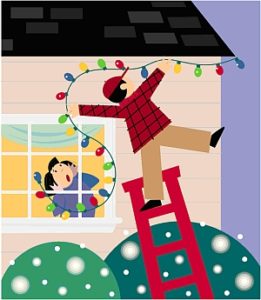

Whether you’re hard at work on the job or stringing twinkling lights, P&J wants to remind you of some important ladder safety tips!
The Bureau of Labor Statistics (BLS) reports that falls from fixed and portable ladders is one of the most common injuries suffered by American workers each year. Falls are the third leading cause of unintentional injury-related deaths and the top cause of nonfatal injuries, according to Injury Facts. In 2017, 36,338 people died from falls at home or at work.
Most of these incidents occur because victims violate the basic rules of ladder safety. Often it seems that people simply do not perceive the significant risks of ladder use. To help prevent ladder injuries at home and at work, use the following tips as a guide:
| Planning |
|---|
| How high do you need to reach? |
| How much weight will the ladder need to hold? |
| What environment will the ladder be used? |
| If indoors, can someone open a door into your ladder? |
| If outdoors, are their overhead electric lines? Uneven ground? |
| Selecting & Inspecting |
|---|
| Make sure you select the right ladder for the job – Will you need an extension ladder or a stepladder? |
| Make sure the weight that your ladder is supporting doesn’t exceed its maximum load rating (including yourself and your materials) and only one person should be on a ladder at a time. |
| Check the length. Proper length is a minimum of 3' extending over the roofline or working surface when using an extension ladder. |
| Inspect your ladder before each use for loose or damaged steps/rungs, spreaders, safety feet, and cracks in the side rails. |
| Clear the area where you will be setting up – don’t place a ladder in front of a door that isn’t locked, blocked, or guarded. |
| Safely Using the Ladder |
|---|
| No matter what kind of ladder you're using, place the base on a firm, solid surface and avoid slippery, wet or soft surfaces. |
| A straight or extension ladder should be placed 1' away from the surface it's resting on for every 4' of the ladder's working length. |
| Securely fasten straight or extension ladders to an upper support if possible. |
| Make sure stepladders are open completely and spreaders locked before climbing. |
| Always keep your body centered between the rails of the ladder. Don’t lean too far to the side while working. |
| Don’t step on the top or top step of the ladder or attempt to climb or stand on the rear section of a stepladder. |
| Never leave a raised ladder unattended. |
| Step down from a ladder if you feel tired or dizzy. |